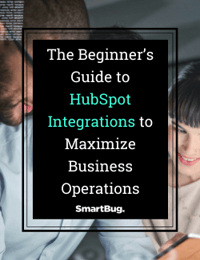
From Data Silos to Seamless Integration: Harnessing the Benefits of HubSpot API Integrations
July 6, 2023
By Brent Worley
In today's fast-paced business environment, streamlining workflows and improving efficiency are crucial for success. One way to achieve this is through application programming interface (API) integrations.
In this blog post, we'll explore the benefits of using API integrations in HubSpot, common use cases, considerations for integrating APIs with HubSpot, and best practices for successful integration.
What Are API Integrations?
Application programming interface integrations allow different software applications to communicate with each other. This means that data can be shared between two or more systems without manual input from users. By automating data transfer, businesses save time and reduce errors caused by human input.
HubSpot is a popular customer relationship management (CRM) platform that offers a range of tools for marketing, sales, and customer service. With API integrations, you can connect HubSpot with other software platforms to improve data accuracy and efficiency.
The Benefits of API Integrations in HubSpot
Let's take a closer look at the benefits of using API integrations in HubSpot.
Improved Data Accuracy and Efficiency
API integrations allow data to be automatically transferred between different software platforms without the need for manual input from users. This reduces the risk of errors caused by human input and improves overall data accuracy. In addition, automating data transfer saves time and resources that can be allocated to other important tasks.
Enhanced User Experience
By integrating third-party tools with HubSpot through APIs, you can streamline workflows and create a better user experience for your team members. For example, if your team uses a social media management tool like Hootsuite or Buffer, you can integrate it with HubSpot so that social media posts are automatically scheduled based on your content calendar.
Increased Productivity Through Real-Time Synchronization
Real-time synchronization allows data to be updated across different platforms immediately after changes are made in one system. This means that everyone on your team has access to the most up-to-date information at all times.
Better Decision-Making Through Access to Comprehensive Data Insights
Integrating different software platforms through APIs provides access to comprehensive data insights that would otherwise require manual analysis from multiple sources. By having all relevant data in one place, businesses can make better-informed decisions based on accurate information.
Common Use Cases for API Integrations in HubSpot
Marketing Automation
Marketing automation is the process of automating repetitive marketing tasks such as email campaigns or social media posting schedules using third-party tools integrated through APIs. For example:
- Integrating Hootsuite with HubSpot allows scheduling social media posts directly from within the CRM.
- Connecting Google Analytics with HubSpot provides detailed insights about website visitors within the CRM itself.
- Using Zapier’s integration capabilities allows automated actions when certain criteria are met, such as creating a new contact record when someone submits a form on SurveyMonkey
Sales Enablement
Sales enablement involves providing sales teams with the necessary resources they need throughout their sales cycle. For example:
- Integrating Calendly or Acuity Scheduling with HubSpot allows prospects to schedule meetings directly from their emails or landing pages.
- Connecting SalesforceIQ or Close.io will give sales reps complete visibility into their leads’ interactions across channels, including email history inside of deals
Customer Service
Customer service teams benefit from having all relevant customer information available at their fingertips, thanks to API integrations. For example:
- Integrating Zendesk or Freshdesk support tickets directly into your contacts’ records inside of HubSpot makes the customer service process easier than ever before for reps handling issues raised by customers.
- Connecting Drift chatbots with HubSpot directly routes incoming chats into HubSpot as new conversations, allowing reps quick access without switching back and forth between screens.
Considerations for Integrating APIs with HubSpot
Before getting started with integrating APIs into your workflow on HubSpot, there are some basic concepts you need to understand.
- Authentication: How does an application verify who is sending requests? OAuth 2.0 standard is used by many services, including Facebook and Google sign-ins, but the application also includes custom authentication methods, depending on which service you’re trying to integrate.
- Endpoints: What URLs do you use when sending requests? These endpoints define which actions you want your third-party tool, service provider, APIs, and so on to perform once it receives our request and response messages.
- Request/response structure: What format does your message have? The request/response structure defines how messages should be structured so both sides know what information needs processing.
Best Practices for Successful API Integration in HubSpot
Here are some best practices worth considering while integrating APIs into your workflow.
First, choose the right third-party tool or vendor for your integration needs. It's important not only to consider functionality but also factors such as security protocols (e.g., SSL), stability and uptime guarantees, pricing models, and more before selecting any vendor or tool set.
Also, ensure data privacy and security protocols are followed. This step is essential whenever you’re working with sensitive client and customer data.
HubSpot API Integrations: A Powerful Tool in Your Business Toolbox
API integrations can be a powerful tool for businesses looking to streamline workflows and improve efficiency. They allow data to be shared between two or more systems without manual input while also providing access to comprehensive data insights that would otherwise require manual analysis from multiple sources.
With HubSpot's API integration capabilities, marketers and sales teams can automate tedious tasks such as social media posting schedules and email campaigns, resulting in improved data accuracy and overall user experience. When integrating APIs into your workflow on HubSpot, it is important to choose the right third-party tools and follow the proper security protocols at all times.
By implementing the above best practices, you will ensure successful API integrations within your business environment that lead to increased productivity through real-time synchronization of data across different platforms.
Still unsure if you are capable of following an integration process from start to finish on your own? SmartBug® has a team of experts to help. Check out the integration services we offer, and reach out whenever you’re ready!

About the author
Brent Worley is the Senior Director of Technical Services at SmartBug. Having started his career in large data software engineering, Brent has spent 14 years of his career designing, developing, and supporting best of breed solutions for his clients. He has expertise in all things data and identity recognition solutions. He currently lives in Conway, Arkansas with his wife and three daughters. Read more articles by Brent Worley.









